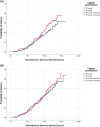Routine vaginal examination to assess labor progress at 8 compared to 4 h after early amniotomy following Foley balloon ripening in the labor induction of nulliparas: A randomized trial
- PMID: 39356052
- PMCID: PMC11609989
- DOI: 10.1111/aogs.14975
Routine vaginal examination to assess labor progress at 8 compared to 4 h after early amniotomy following Foley balloon ripening in the labor induction of nulliparas: A randomized trial
Abstract
Introduction: Our objective was to compare the performance of the first vaginal examination at 8 vs 4 h after amniotomy following Foley ripening in nulliparous labor induction.
Material and methods: A randomized controlled trial was conducted from June 2021 to January 2022. 210 nulliparas at term for labor induction were randomized: 105 each to first vaginal examination at 8 or 4 h after Foley balloon ripening and amniotomy. Titrated oxytocin infusion was routinely commenced after amniotomy to expedite labor. Primary outcomes were the amniotomy-to-delivery interval (non-inferiority hypothesis) and maternal satisfaction with their allocated labor care (superiority hypothesis) within 24 h after delivery. Analyses performed using t-test, Mann-Whitney U test, and Chi-squared test as appropriate.
Results: The amniotomy-to-delivery interval was mean ± standard deviation 8.7 ± 3.4 vs 8.4 ± 3.7, mean difference 0.4 (97.5% CI: -0.7 to 1.5) hours, p = 0.442 within the pre-specified 2-hour non-inferiority margin, and maternal satisfaction score with allocated labor care was median [interquartile range] 8[7.5-10] vs 8[7.0-10], p = 0.248 for 8 vs 4 h arms, respectively. The amniotomy to first vaginal examination intervals was 5.9 ± 2.3 vs 3.6 ± 1.0 h, p < 0.001, and the number of vaginal examinations was 2[1-2.5] vs 3 [2, 3], p < 0.001 for 8 vs 4 h, respectively. The first vaginal examination was less likely to have been performed as scheduled, more likely to be indicated by the urge to bear down, and non-reassuring cardiotocography for the 8 h arm (p < 0.001). Spontaneous vaginal delivery was significantly more likely and instrumental vaginal delivery less likely, but cesarean rate was not significantly different for the 8 h arm (p = 0.017).
Conclusions: A routine first vaginal examination at 8 h compared to 4 h is non-inferior for the time to birth but does not increase maternal satisfaction although the number of vaginal examinations is fewer. The increase in spontaneous vaginal delivery and reduction in instrumental vaginal delivery rates warrant further powered primary evaluation.
Keywords: Foley; amniotomy; cervical ripening; cesarean; interval to delivery; labor induction; labor progress; maternal satisfaction; oxytocin; vaginal delivery; vaginal examination.
© 2024 The Author(s). Acta Obstetricia et Gynecologica Scandinavica published by John Wiley & Sons Ltd on behalf of Nordic Federation of Societies of Obstetrics and Gynecology (NFOG).
Conflict of interest statement
The authors report no conflict of interest.
Figures


Similar articles
-
Routine vaginal examination to assess labor progress at 8 compared to 4 hours after early amniotomy following Foley balloon ripening in the labor induction of multiparas: a randomized trial.Am J Obstet Gynecol MFM. 2024 Apr;6(4):101325. doi: 10.1016/j.ajogmf.2024.101325. Epub 2024 Mar 4. Am J Obstet Gynecol MFM. 2024. PMID: 38447677 Clinical Trial.
-
Six compared with 12 hours of Foley balloon placement for labor induction in nulliparous women with unripe cervices: a randomized controlled trial.Am J Obstet Gynecol MFM. 2023 Nov;5(11):101157. doi: 10.1016/j.ajogmf.2023.101157. Epub 2023 Sep 17. Am J Obstet Gynecol MFM. 2023. PMID: 37722505 Clinical Trial.
-
Tugging the Foley catheter balloon every three hours in induction of labor after one previous cesarean: a randomized controlled trial.Am J Obstet Gynecol MFM. 2025 Feb;7(2):101579. doi: 10.1016/j.ajogmf.2024.101579. Epub 2024 Dec 12. Am J Obstet Gynecol MFM. 2025. PMID: 39674509 Clinical Trial.
-
Early vs. delayed amniotomy in individuals undergoing pre-induction cervical ripening with transcervical Foley balloon: a meta-analysis.Am J Obstet Gynecol MFM. 2024 Aug;6(8):101408. doi: 10.1016/j.ajogmf.2024.101408. Epub 2024 Jun 17. Am J Obstet Gynecol MFM. 2024. PMID: 38897352
-
Early amniotomy after cervical ripening for induction of labor: a systematic review and meta-analysis of randomized controlled trials.Am J Obstet Gynecol. 2020 Apr;222(4):320-329. doi: 10.1016/j.ajog.2019.07.049. Epub 2019 Aug 6. Am J Obstet Gynecol. 2020. PMID: 31398311
References
-
- Martin JA, Hamilton BE, Osterman MJK, Driscoll AK. Births: final data for 2018. Natl Vital Stat Rep. 2019;68(13):1‐47. - PubMed
-
- Ehrenthal DB, Jiang X, Strobino DM. Labor induction and the risk of a cesarean delivery among nulliparous women at term. Obstet Gynecol. 2010;116(1):35‐42. - PubMed
-
- Bleicher I, Dikopoltsev E, Kadour‐Ferro E, et al. Double‐balloon device for 6 compared with 12 hours for cervical ripening: a randomized controlled trial. Obstet Gynecol. 2020;135:1‐1160. - PubMed
-
- Jones MN, Palmer KR, Pathirana MM, et al. Balloon catheters versus vaginal prostaglandins for labour induction (CPI collaborative): an individual participant data meta‐analysis of randomised controlled trials. Lancet. 2022;400(10364):1681‐1692. - PubMed
-
- Diederen M, Gommers J, Wilkinson C, Turnbull D, Mol B. Safety of the balloon catheter for cervical ripening in outpatient care: complications during the period from insertion to expulsion of a balloon catheter in the process of labour induction: a systematic review. BJOG. 2018;125(9):1086‐1095. - PubMed
Publication types
MeSH terms
LinkOut - more resources
Full Text Sources

